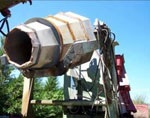Mechanical Plating

Mechanical zinc plating is accomplished by tumbling small parts in a drum with zinc and proprietary chemicals. Small iron and steel parts - usually limited in size to about 8-9 inches (200-300 mm) and weighing less than one pound (0.5 kg) - are cleaned and flash copper-coated before loading into a plating barrel. The barrel is then loaded with proprietary chemicals, glass beads and zinc powder and tumbled. During tumbling, the glass beads peen zinc powder onto the part. Once finished, the parts are dried and packaged, or post-treated with a passivation film, dried, and packaged.
As mentioned, mechanical plating can only be appliedto small parts limited to the capacity of the drum. Furthermore, the materials must be simple in design to ensure peening to all surfaces. Mechanical zinc plating is most commonly used on high-strength fasteners and other small parts not suitable for hot-dip galvanizing.
Coating Characteristics
Mechanical plating consists of a flash coating of copper followed by the zinc coating. Coating thickness requirements contained in ASTM Specification B695 range from 0.2-4.3 mils (5 to 110 µm). While thicker coatings are possible, the common thickness on commercial fasteners is 2 mils (50 µm). The coating density is approximately 0.45 oz/ft2/mil compared to the hot-dip galvanized coating density of about 0.6 oz/ft2/mil. The hot-dip coating has over 30% more zinc per unit volume than the mechanical coating.
The coating, upon micro cross-section, appears to consist of flattened particles of zinc loosely bonded together. The bond between zinc and steel, and zinc-to-zinc, being mechanical in this process, is weaker than the metallurgical bond found in hot-dip galvanizing. Edge, corner and thread coating thicknesses are usually lower at these sharp radii areas due to minimal peening action at these locations.
Because of the application process (tumbling and peening), the coating thickness can vary throughout the part. Complex designs with recesses or blind holes as well as edges, corners and threads can have inconsistent or non-existent coatings due to inaccessibility to the peening action of the glass beads. It is also importantthe compaction agents (beads) are large enough to avoid being lodged in any cavities, recesses, or small threads inthe part. The coating is mechanically-bonded to the steel with a similar adhesion to zinc plating.
